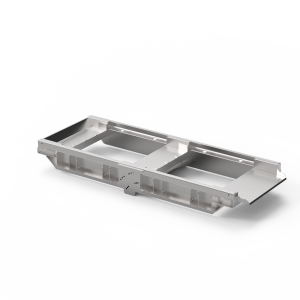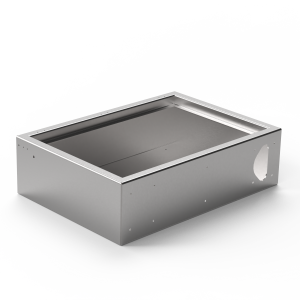
Switching to KOOI-ReachForks saved Isover around 35% on their internal transport costs. Their trucks can now pick up four pallets at once instead of just two. That doesn’t just cut down on the number of trips, it also produces substantial savings on fuel. The new approach fits in seamlessly with their business philosophy.
Any smart builder builds insulation into his house. Preferably with Isover products, if the manufacturer from Etten-Leur (Netherlands)) has anything to do with it. Proper insulation increases comfort in the home as well as benefiting the environment, and of course there are significant energy savings. “So in a way it’s not surprising that we were quick to see the advantages of these reach forks”, says Warehouse & Shipping Manager Roy Brown of Saint-Gobain Isover Benelux. “We started with tests in 2006, and we now have three trucks using this system, with plans for more.”
THE PURSUIT OF OPTIMALISATION
Forklift trucks are an indispensable element of Isover’s internal logistics. A constant stream of palletised insulation products flows from the various production departments. In roll or sheet form, the dimensions are as diverse as the applications. The weight per pallet fluctuates between 260 and 350 kg. The forklift trucks take the pallets to the correct storage location, indoors or outside. The firm had made a start on rationalising their transport arrangements, fitting their trucks with twin fork adjusters. For longer journeys they used trailers attached to the forklifts. “Of course we were looking for ways to improve things still further”, adds Roy Brown during our tour of their seemingly endless storage facilities. “In discussions with our lift truck supplier Gunco we had explored the possibility of using KOOI-ReachForks on multi load handlers. It would make a big difference if we could carry four pallets at a time instead of two.”
SAFER AND EASIER
A visit to a company who were already using the KOOI hydraulic telescoping forks brought the decision that much closer. Brown saw for himself how KOOI-ReachForks provide a practical method of doubling fork lengths when required. “We don’t want to be driving around with fixed 2400 mm long forks on the trucks”, he explains. “With no load in place that is downright dangerous. In any case, we don’t have the space for a truck with those dimensions inside the production rooms.” MSE-Forks fabricated the telescopic forks and, working with their dealer in the Netherlands, forklift attachment specialists Griptech BV, supplied a fully-operational multi load handler system. These can be adjusted to any desired width, allowing a single truck unit to pick up one, two or four pallets. The first telescopic forks were taken into use by Isover in 2006 for a period of intensive testing. Roy Brown: “They worked fine, but guiding them in and out of the pallets took some skill. This was mainly down to their thickness and shape. The inner and outer forks weren’t completely flush, so the forks occasionally got stuck under the pallet.”
OTHER FORKLIFT TRUCKS
MSE-Forks have now developed a slimmer version where the forks sit completely flush. Clever design means the outer tubes no longer contact the lower pallet timbers, and getting stuck is a thing of the past. The new units really suit Isover’s truck drivers, who are full of enthusiasm for the changeover. This is partly because they are now driving a different type and brand of lift truck. In place of their usual 2 tonne machines they are now driving Linde’s H35T models. These 3.5 tonne LPG trucks have the additional lifting capacity required to work with four pallets simultaneously. “They are also quieter, more ergonomic, and they are technically a better match for the trailers we pull”, says Brown, indicating one of the new machines. “We couldn’t tow and brake trailers safely with our other trucks with their torque conversion automatic gearboxes. That’s not a problem for the Linde machines with their hydrostatic drive”. Brown has a fixed working method when using the Linde trucks. The drivers never travel forwards with the unloaded forks extended and set wide apart. The palletised loads they carry are fairly high, so in principle all loaded trips travel in reverse. The Linde truck seat can rotate by 20 degrees, making it much more comfortable to drive like this. They also have a raised cab for extra visibility and a flashing light that extends above the height of the top pallet. “Safety is paramount for us”, says Roy Brown in conclusion. “We have intensive activity outside with terminal tractors, and they need to see when there are forklifts about.”

WIDER TRAILERS
They have also recently started using trailers in a bid to optimalise the efficiency of their internal transport system. Instead of a train of five short trailers each with just two pallets, they now pull two big trailers with the pallets loaded two deep and two wide. It’s a logical step, because the forklift trucks can also pick up and move the loads in this same block format. “Thanks to the double KOOI-ReachForks we can now also load our freight vehicles from one side”, explains Roy Brown, while shift boss Jan van Leijsen demonstrates the loading process. “All our transport operations now go faster than before.”
Of course the 3.5 tonne trucks use more fuel than the lighter 2 tonners. “That’s true, I do need to fill up more often”, says one of the experienced drivers. “The difference is about 15%, because we also need more energy for the hydraulic telescoping forks. But we can shift 30 to 40% more product, so we save a lot of fuel in the end. And don’t forget that means less vehicle movements in total, so less chance of damage. We also need fewer trucks and fewer drivers. So the plans are already in place for a further expansion of the system.”
















